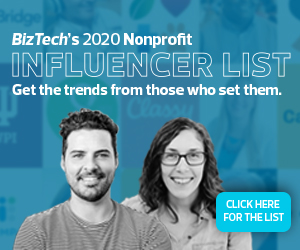Why Business Data Analytics for Nonprofits Is Critical
Demand for data experts is on the rise as companies look to leverage data lakes, connect data silos and deliver on the potential of this digital resource. As noted by the MIT Sloan Management Review, data science took top spot in 2019 as the most promising IT position with a 56 percent rise in career opportunities over the previous year.
Big Data exists as a structural consequence of digital transformation. For nonprofits, this means that as fundraising drives move online, mobile applications are created to make donor access easier, and post-campaign debriefs integrate paper surveys into nonprofit storage servers, data volumes grow exponentially.
While making best use of this data isn’t a requirement — many organizations leverage only basic information such as transaction or customer service histories to streamline existing processes — the cost of storing and securing data at scale can quickly outpace these incremental advantages, making effective analytics a win-win scenario.
What Are the Benefits of Business Analytics for Nonprofits?
Data analytics, which TechTarget defines as “the process of examining data sets to draw conclusions about the information they contain,” connects human intuition with data-driven insight to inform business strategy. Applied to the current COVID climate, lived experience suggests that charitable giving will naturally contract. Data analysis both confirms this assertion and — more importantly — helps articulate underlying causes.
In practice, the benefits of data and business analytics for nonprofits are spread across three key areas:
- Description: Descriptive analytics focus on data aggregation to deliver information on what’s happening right now. For nonprofits, this might include analysis of current donor demographics, total giving amounts and overall contributions over time. Descriptive analysis helps streamline reporting and statistical modeling and is also essential for charitable organizations to meet evolving compliance requirements.
- Prediction: Predictive analytics speak to emerging trends. Using a combination of current and historical data, predictive tools can help identify donation shifts across key demographics and assess the potential impact of new marketing campaigns.
- Prescription: Prescriptive analytics provide actionable insight to inform current business operations, such as where campaign efforts will likely yield best results or which donors will be most receptive to recurring outreach.
MORE FROM BIZTECH: In lieu of live events, how nonprofits can keep raising money.
Data Analytics Vendors for Nonprofits
It’s one thing to recognize the value of data analysis, but it’s another to effectively implement this approach. This is especially true for nonprofits facing limited IT budgets and reduced staffing numbers, so there are some programs that can help get analytics operations off the ground.
Google Analytics is a free, cloud-based data analysis solution that helps organizations track and measure key website data, including overall visitor traffic, visitor referral points, conversion rates and time spent per page, per user. Getting started with Google Analytics is simple: Create an Analytics account using an existing Google account and link up to 50 websites for monitoring and analysis. You’ll be provided with a unique tracking code that must be installed on every web page you want to analyze, and you can customize which data is tracked, shared and reported from your Google Analytics dashboard.
While free tools are helpful, there is a limit to what they can do. More powerful tools, like Microsoft’s Power BI, can provide deeper trends and insights to help optimize not only donor data, but also business operations. Calusa Waterkeeper, a Southwest Florida chapter of the nonprofit water advocacy group Waterkeeper Alliance, used Power BI Pro to collect data on water quality and visualize trends in various chemicals over time. This allowed the group to target their work in a more efficient way and piece together their mission’s puzzle.
Once the data is being tracked, it’s important to determine which points to prioritize. To improve giving outcomes, organizations need to determine the metrics and key performance indicators that best measure current success and help inform ongoing strategy. While metrics and KPIs are similar in form — both are quantifiable measurements — they differ in function.
For example, your nonprofit might use a metric tied to specific action — such as how many visitors fill out website contact forms — to assess current donor engagement. The connected KPI defines a strategic business goal, such as a specific increase in contact form completion. Regularly measuring your metric helps determine how close you are to reaching your desired KPI.
To get the most out of donors, it’s important to know basic information about them. As noted by the Stanford Social Intervention Review, demographic data has a significant impact on donors’ total giving amounts, how often they give and what type of organizations they support. Making best use of fundraising data means leveraging current donor information to predict potential trends and determine the best-fit metrics and KPIs to assess the impact of new policies.
MORE FROM BIZTECH: More employers are using AI in their hiring practices.
If historic data analysis shows that middle-class donors tend to give more during summer, teams can ramp up targeted email campaigns as the weather improves. Relevant metrics include email open and response rates, while KPIs represent progress toward target goals. For example, recent data indicates that the average open rate for nonprofit marketing emails is just over 25 percent. If current metrics show an open rate of 20 percent, aiming for a KPI of 30 percent isn’t unreasonable.
Effectively measuring the impact of analytics is crucial in making sure your organization is making the right decisions. In the example above, a new email campaign might boost open rates temporarily, but does that carry through across charitable giving rates over months — or years? This is the critical benefit of ongoing, integrated analytics: process and performance visibility across the scope and scale of your nonprofit organization.
How to Turn Assessment to Action
Nonprofits now face the challenge of driving new donations without the benefit of in-person interactions, paired with the financial frustration faced by many givers thanks to current crisis conditions.
Data analytics offers a way to bridge the gap between simple assessment of existing data sets and insight-driven action based on demographic and donor trends. Armed with the right tools, metrics and KPIs, nonprofits can both identify new opportunities and adapt existing practices to drive consistent charitable giving.










